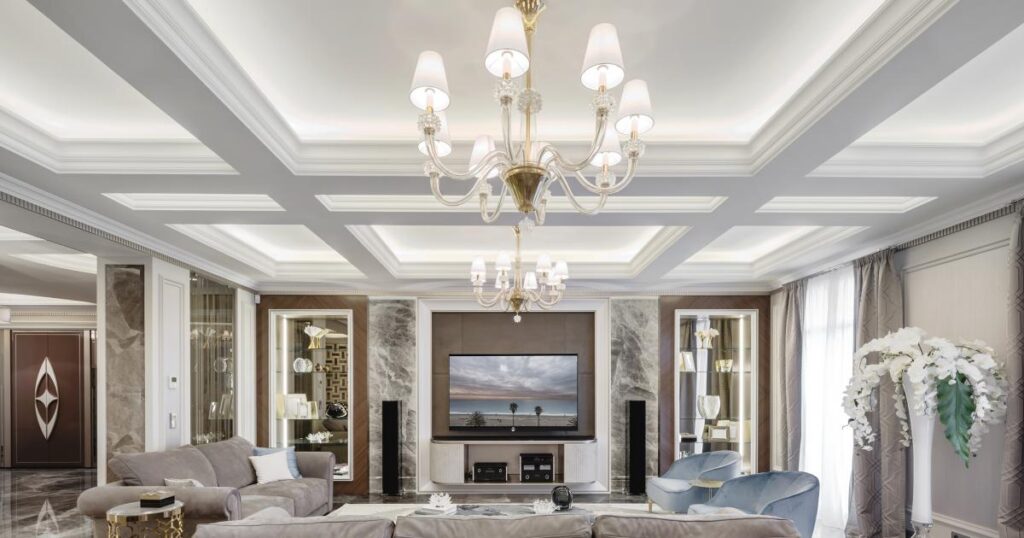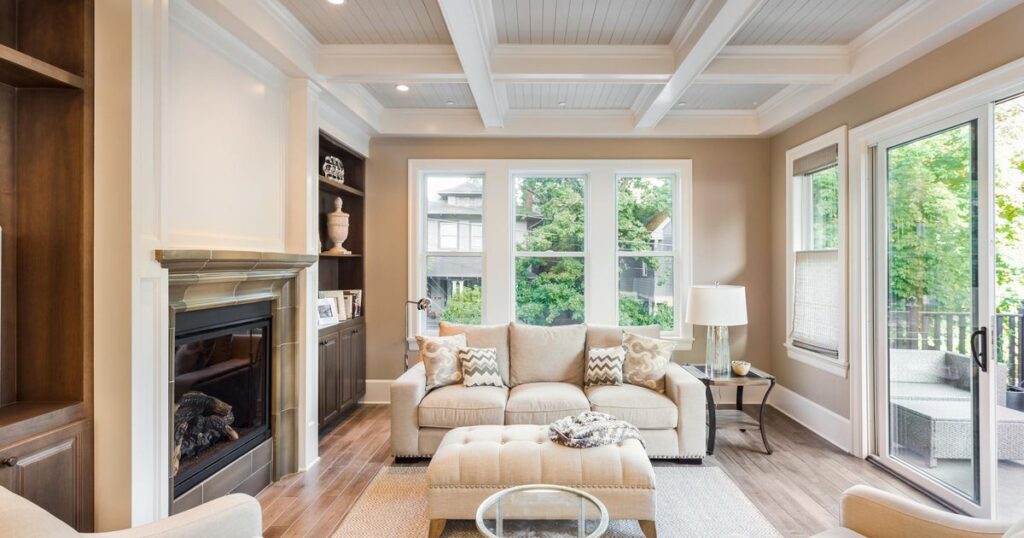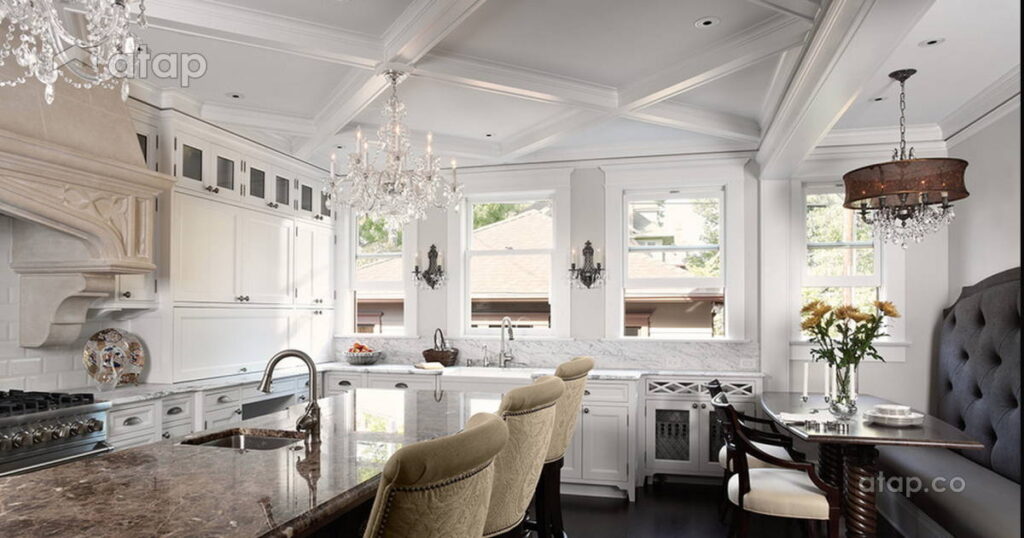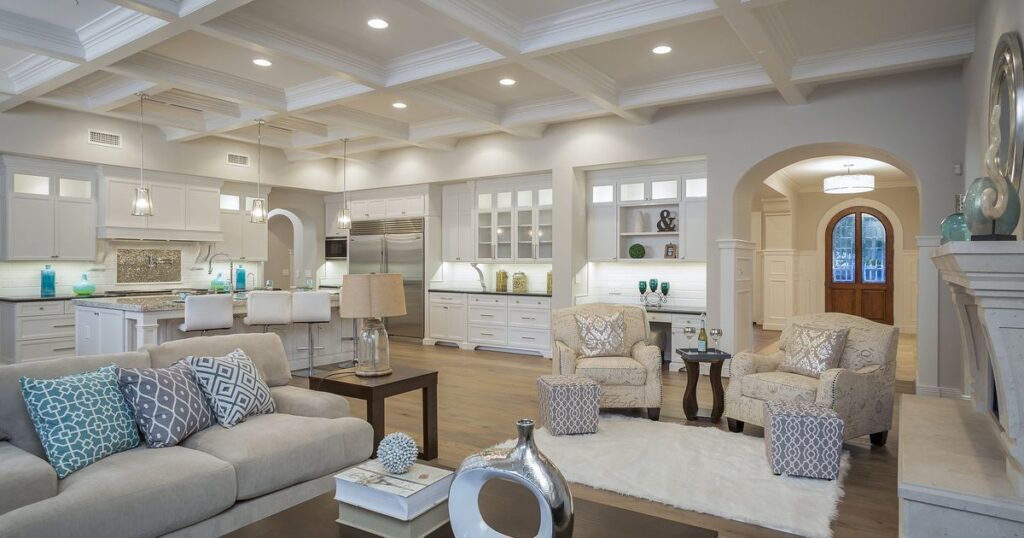In conversion of a space, the ceiling is usually a neglected area. Nevertheless, the ceiling can become a sensational center of any room, make the overall design grander and leave a memorable impression. The coffered ceiling is one of the most favorite ideas of ceiling design among both the house owners and interior designers. The coffered ceiling not only looks good, but it also provides depth and texture to an interior room. In this definitive guide, we shall examine the characteristics, the advantages of the coffered ceilings, design concepts, its installation and the historical background of the coffered ceilings. We are also going to see how you can use this design in your home or office. Homewavey intends to provide the reader with an informative guide about their interior design.
What is a Coffered Ceiling?
A coffered ceiling refers to a ceiling which is structured in such a way that it contains recessed panels or squares; this brings out a grid like method throughout the total ceiling. The panels, which usually consist of beams or mouldings around them, provide depth to the space and are visually attractive. Traditionally, coffered ceilings were installed in palaces and other major constructions in order to provide the effect of charm and luxury. This style has remained in fashion today to be linked to sophistication and eternal beauty.
This appears to be a basket weave made up of the recessed panels, and is thus termed a coffer originating in the Latin word cophinus which means basket. Wood, plaster, or even more modern, suchlike gypsum board are some of the materials that can be used to make coffered ceilings. Although traditionally viewed on big spacious rooms of formal styles, they can be easily adjusted to other sizes and styles of rooms. Ceiling Design ideas help you create your space as stylish as your wish.
What are the Benefits of Coffered Ceiling

Having a coffered ceiling in your interior design has a few benefits. Aesthetically, to functional, here are some important advantages:
Aesthetic Appeal
There is architectural appeal in a coffered ceiling and it makes a room appear more sophisticated and elegant. The ceiling itself also has a natural inclination to the eyes due to the pattern and the depth of the design which makes it attractive as well as causes the rest of the space to appear more expansive. Does your living room, your dining space, or even a home office need a sense of luxury to bring its ambiance to a new level? If so, then a coffered ceiling can help you change the way your place looks significantly.
Values of Properties are Increased
This is because coffered ceilings are commonly related to a luxury design and therefore, coffered ceilings have the potential to make your home worth great sums. This aspect happens to be an investment which creates a visual drain and in most instances allows a home to stand out among the competition in a dynamic real estate market.
Better Way Sound in Rooms
Through a coffered ceiling, a room’s acoustics can be controlled with the help of a recessed ceiling. They work well in large open concept buildings or in spaces where the quality of the sound matters most, like the home theater, or audio rooms.
Concealing Imperfections
Another way in which the coffee ceiling can be cleverly used is to cover faults on the ceiling like cracks and irregular surfaces or hidden wires which can otherwise be an eyesore. The structure stands a chance to offer a clean look via incorporation of beams and recessed panels.
Individualization and Flexibility
A coffered ceiling is quite customisable to various design tastes. Be it the more traditional, classical style or the more modern and minimalist design, the beams and the panels can be modified to suit your dream. Coffered ceilings provide endless customization: in design, detail, color, hue, etc. People do look for the latest home interior designs though the design always goes with the style you want.
What are The Materials Used in Coffered Ceilings

Selecting a coffered ceiling to use in your area will provide you with several options of materials. The type of the material you choose will influence the appearance of the whole structure as well as the expenses of the work. The following are some of the standard materials to build coffered ceilings:
Wood
Wood: It is one of the best adored coffered ceiling materials due to its coziness and natural essence. It could be painted or stained in order to fit the color scheme of the room. Depending on their quality, high-quality hard woods such as oak, maple, and cherry are common, whereas an economical substitute is medium-density fiberboard (MDF).
Plaster
Plaster is characterized by classical and sophisticated appearance, which is typical of older buildings and luxury houses. It can be modeled into sophisticated shapes and is very customizable. Plaster coffered ceilings are usually more costly as they give a luxurious look.
Gypsum Board
A newer material utilised during the installation of coffered ceilings is known as Gypsum board. It is portable, light and workable. One can easily shape gypsum boards into patterns and they can also be cheaper than wood or plaster.
Polyurethane/PVC
Polyurethane or PVC is an option for those of us on a budget. These are light in weight, strong and are able to rock the appearance of wood or plaster. They are moisture-proof as well, so they are easy to put in bathrooms or kitchens.
Which are The Best Design Ideas for Coffered Ceilings
What is so nice about coffered ceilings is, they are flexible. Regardless of your desire for the classic, vintage or more modern look, coffered ceilings can perfectly suit the various interior designs. The following are a few design concepts to get you going on your next upgrade on a ceiling:
Traditional style of the classics
Wood beams should be richly stained to make the room have that antique and classic appearance like that of walnut or dark mahogany. To offer some contrast and to bring contrast between dark beams and blithe ceiling, the recessed panels may be painted outside in a neutral light, including white, cream. The design is practical in the living or dining area that has traditional furniture.
Design of Modern Minimalism
Even though you want it to be modern in a sleek manner, minimize its appearance by adopting minimalist design strategies through simpler and clean lines and lighter finishes. Bare beams can be white or pale gray and make a simple statement, which is appropriate in modern buildings. You would even be able to insert recessed lighting into the panels to give an efficient, albeit minimalistic, solution to the lighting.
Rustic Style
Coffered ceiling using rustic, rough-hewn beams or reclaimed wood will look ideal in a home of a farmhouse or a cabin-style. The wood element gives this room warmth, character and the coffered aesthetic makes this space make a statement.
Designing of Geometric Patterns
To obtain a more modern and daring appearance, choose geometric patterns in square or rectangular panels. The advantage of this contemporary style is that it has fresh, clean lines, and this is a style that can be enhanced with other mediums, such as wood, gypsum to create a bespoke, unique combination of ceiling.
Lighting and integrated Coffered Ceiling
An integrating panel lighting into such had a wonderful effect of increasing the beauty of a coffered ceiling. To strategically point out the space during the night, strip led lights or recessed downlights may be ready along the beams or even in the panels to offer a lovely and warm atmosphere.
As renowned Australian interior designer Darren Palmer once said, “Good design is not about what’s on trend; it’s about creating spaces that are meaningful and enduring.” Undoubtedly, a coffered ceiling reflects such a philosophical construct. Its classic style and adaptable nature mean it remains a wanted element in homes all the way across Australia, constructing spaces that are elegant and functional.
How to Get Installation of a Coffered Ceiling

Coffered ceiling is a skillful job that involves planning the installation. It has been a project most suitable in the hands of professionals because it is complex. This is a rough idea of how it goes:
Preparation
The initial procedure is by clearing the room and setting up its ceiling ready to be installed. This involves the space measurement, layout planning of grid structure as well as making sure that the ceiling structure can support the weight of the beams.
Framing
The other is the framing of beams. Wood and metal can be used in this but this can be achieved with any type of material based on your design and style you desire.
Panel Installation
After the frame is in place, the recessed panels are fitted. These may be wooden and/or gypsum or any other material of choice. The panels will be installed into the grid and the joints covered to give it a smooth finish.
Finishing Touches
The last process involves finishing the beams and panels either by painting or staining them, as well as any trim or moldings that may be wanted and finally the lighting fixtures that one may prefer using.
Conclusion
Coffered ceiling is one of those classic and all-purpose features that introduce the air of luxury along with architectural grandeur to the room. A coffered ceiling can instantly add a feeling of opulence to any living room, but also can serve well in improving the acoustics of a home theater. The coffered ceiling may be tailored to meet any interior style (modern or conventional) since there are now numerous material choices and design options available.
A coffered ceiling acts both as a cosmetic investment and as an element of functionality; it is understandable why this solution of interior design remains a popular one among interior designers around the globe. In Australia, if you are seeking to learn more about the coffered ceiling and interior design, you may like The Society of Interior Designers of Australia (SIDA).



